Related Research Articles

An electronic calculator is typically a portable electronic device used to perform calculations, ranging from basic arithmetic to complex mathematics.

The volt is the unit of electric potential, electric potential difference (voltage), and electromotive force in the International System of Units (SI). It is named after the Italian physicist Alessandro Volta (1745–1827).

A power supply is an electrical device that supplies electric power to an electrical load. The main purpose of a power supply is to convert electric current from a source to the correct voltage, current, and frequency to power the load. As a result, power supplies are sometimes referred to as electric power converters. Some power supplies are separate standalone pieces of equipment, while others are built into the load appliances that they power. Examples of the latter include power supplies found in desktop computers and consumer electronics devices. Other functions that power supplies may perform include limiting the current drawn by the load to safe levels, shutting off the current in the event of an electrical fault, power conditioning to prevent electronic noise or voltage surges on the input from reaching the load, power-factor correction, and storing energy so it can continue to power the load in the event of a temporary interruption in the source power.

A DC connector is an electrical connector for supplying direct current (DC) power.

An adapter or adaptor is a device that converts attributes of one electrical device or system to those of an otherwise incompatible device or system. Some modify power or signal attributes, while others merely adapt the physical form of one connector to another.
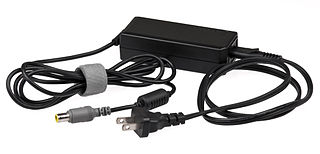
An AC adapter, AC/DC adapter, or AC/DC converter is a type of external power supply, often enclosed in a case similar to an AC plug. Other common names include wall wart, power brick, wall charger, and power adapter. Adapters for battery-powered equipment may be described as chargers or rechargers. AC adapters are used with electrical devices that require power but do not contain internal components to derive the required voltage and power from mains power. The internal circuitry of an external power supply is very similar to the design that would be used for a built-in or internal supply.
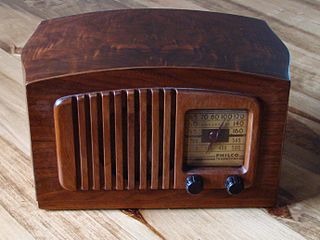
The term All American Five is a colloquial name for mass-produced, superheterodyne radio receivers that used five vacuum tubes in their design. These radio sets were designed to receive amplitude modulation (AM) broadcasts in the medium wave band, and were manufactured in the United States from the mid-1930s until the early 1960s. By eliminating a power transformer, cost of the units was kept low; the same principle was later applied to television receivers. Variations in the design for lower cost, shortwave bands, better performance or special power supplies existed, although many sets used an identical set of vacuum tubes.

USB On-The-Go is a specification first used in late 2001 that allows USB devices, such as tablets or smartphones, to act as a host, allowing other USB devices, such as USB flash drives, digital cameras, mouse or keyboards, to be attached to them. Use of USB OTG allows those devices to switch back and forth between the roles of host and device. A mobile phone may read from removable media as the host device, but present itself as a USB Mass Storage Device when connected to a host computer.
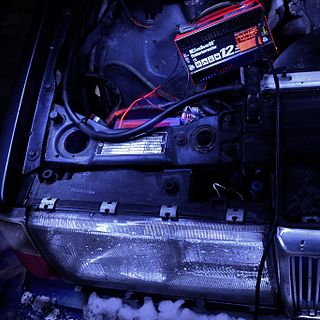
A battery charger, or recharger, is a device that stores energy in a battery by running an electric current through it. The charging protocol depends on the size and type of the battery being charged. Some battery types have high tolerance for overcharging and can be recharged by connection to a constant voltage source or a constant current source, depending on battery type. Simple chargers of this type must be manually disconnected at the end of the charge cycle. Other battery types use a timer to cut off when charging should be complete. Other battery types cannot withstand over-charging, becoming damaged, over heating or even exploding. The charger may have temperature or voltage sensing circuits and a microprocessor controller to safely adjust the charging current and voltage, determine the state of charge, and cut off at the end of charge.
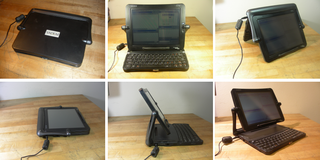
The Vadem Clio is a handheld PC that ran Windows CE H/PC Pro 3.0. It was released in 1999. Data Evolution Corporation currently owns the rights to the Clio.

The Sharp EL-8, also known as the ELSI-8, was one of the earliest mass-produced hand-held electronic calculators and the first hand-held calculator to be made by Sharp. Introduced around the start of 1971, it was based on Sharp's preceding QT-8D and QT-8B compact desktop calculators and used the same logic circuits, but it was redesigned to fit in a much smaller case.
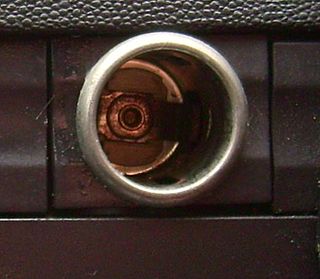
An automobile auxiliary power outlet in an automobile was initially designed to power an electrically heated cigarette lighter, but became a de facto standard DC connector to supply electrical power for portable accessories used in or near an automobile directly from the vehicle's electrical system. Such include mobile phone chargers, cooling fans, portable fridges, electric air pumps, and power inverters.

A charging station, also known as a charge point or electric vehicle supply equipment (EVSE), is a piece of equipment that supplies electrical power for charging plug-in electric vehicles.

A charge controller, charge regulator or battery regulator limits the rate at which electric current is added to or drawn from electric batteries to protect against electrical overload, overcharging, and may protect against overvoltage. This prevents conditions that reduce battery performance or lifespan and may pose a safety risk. It may also prevent completely draining a battery, or perform controlled discharges, depending on the battery technology, to protect battery life. The terms "charge controller" or "charge regulator" may refer to either a stand-alone device, or to control circuitry integrated within a battery pack, battery-powered device, or battery charger.
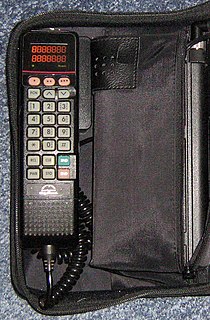
The Motorola bag phone is the colloquial name for a line of personal transportable cellular telephones manufactured by Motorola, inc. from 1988 to 2000.
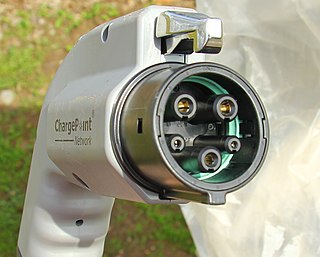
SAE J1772, also known as a J plug or Type 1 connector after its international standard, IEC 62196 Type 1, is a North American standard for electrical connectors for electric vehicles maintained by SAE International under the formal title "SAE Surface Vehicle Recommended Practice J1772, SAE Electric Vehicle Conductive Charge Coupler".

The Sharp QT-8D Micro Compet, a small electronic desktop calculator, was the first mass-produced calculator to have its logic circuitry entirely implemented with LSI integrated circuits (ICs) based on MOS (metal-oxide-semiconductor) technology. When it was introduced in late 1969, it was one of the smallest electronic calculators ever produced commercially. Previous electronic calculators had been about the size of a typewriter and had logic circuits built from numerous discrete transistors and diodes or small- to medium-scale ICs. The QT-8D's logic circuits were packed into just four LSI ICs.
In 2009, a European Commission initiative resulted in the specification of a common external power supply for use with data-enabled mobile phones sold in the European Union. The external power supply is the AC electric power adapter that converts household AC electricity voltages to the much lower DC voltages needed to charge a mobile phone's internal battery. Although compliance is voluntary, a majority of the world's largest mobile phone manufacturers agreed to make their applicable mobile phones compatible with Europe's common external power supply specification.
The initial versions of the USB standard specified connectors that were easy to use and that would have acceptable life spans; revisions of the standard added smaller connectors useful for compact portable devices. Higher-speed development of the USB standard gave rise to another family of connectors to permit additional data paths. All versions of USB specify cable properties; version 3.x cables include additional data paths. The USB standard included power supply to peripheral devices; modern versions of the standard extend the power delivery limits for battery charging and devices requiring up to 100 watts. USB has been selected as the standard charging format for many mobile phones, reducing the proliferation of proprietary chargers.
References
- 1 2 3 4 5 Nigel Tout. "Sharp QT-8B "micro Compet"". Vintage Calculators Web Museum. Retrieved October 2, 2010.
- ↑ Shinichiro Osaki. "シャープ EL シリーズ (ポケット蛍光管 タイプ): QT-8B" [Sharp EL series (pocket fluorescent-tube type): QT-8B]. Dentaku Museum (in Japanese). Retrieved October 4, 2010.
The release price was 117,000 yen. (発売当時の価格は117,000円であった。, Hatsubai touji no kakaku wa 117,000 en deatta.)
- ↑ John R. Free (June 1971). "Microelectronics Shrinks the Calculator". Popular Science. 198 (6): 111. ISSN 0161-7370 . Retrieved October 10, 2010.
- ↑ "CPI Inflation Calculator". Bureau of Labor Statistics . Retrieved October 10, 2010.
- 1 2 3 4 Markus Sigg. "Sharp Micro Compet QT-8B". Rechenkasten (in German). Retrieved October 5, 2010.
(For battery capacity, see photo of original Sharp batteries, marked with 1200 mAh capacity.)
"...das Ladegerät, der Micro Compet Adaptor QTA-2. ... Mit einem Hebel an der Unterseite des Ladegeräts kann man den Rechner befestigen. Während des Ladens darf man auch rechnen. (...the charger, the Micro Compet Adapter QTA-2. ... With a lever on the underside of the charger, one can fasten down the calculator. While charging, one may also calculate.)"
"Im Fehlerfall zeigt der Micro Compet "0.0.0.0.0.0.0.0." an. (On error the Micro Compet displays "0.0.0.0.0.0.0.0.".)" - ↑ Sharp Corporation (August 1970). "(Advertisement) How did we make Micro Compet so portable?". IEEE Spectrum. 7 (8): 108. doi:10.1109/MSPEC.1970.5213522. ISSN 0018-9235.
Sharp Corporation (November 1970). "(Advertisement, untitled)". IEEE Spectrum. 7 (11): 110. doi:10.1109/MSPEC.1970.5213049. ISSN 0018-9235. - 1 2 Rick Bensene. "Burroughs C3146 Electronic Calculator". The Old Calculator Web Museum. Retrieved October 4, 2010.
(Though this describes the C3146, most of the information also applies to the QT-8B.)